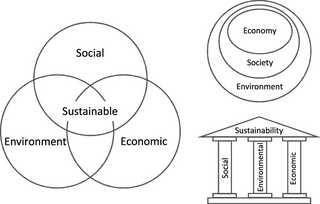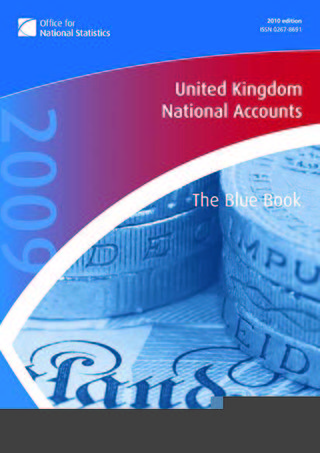History
Many economists, scientists, and other scholars have theorized about adjusting macroeconomic indicators to account for environmental change. The idea was developed early on through the work of Nordhaus and Tobin (1972), Ahmad et al. (1989), Repetto et al. (1989), and Hartwick (1990). [8]
In 1972, William Nordhaus and James Tobin introduced the first model to measure the annual real consumption of households, called the Measure of Economic Welfare (MEW). [9] MEW adjusts GDP to include the value of leisure time, unpaid work, and environmental damages. [9] They also defined a sustainable MEW (MEW-S) value, and their work was the precursor to more sophisticated measures of sustainable development.
Repetto further explored the impact that the failure of resource-based economies to account for the depreciation of their natural capital could have, especially by distorting evaluations of macroeconomic relationships and performance. [10] He and his colleagues developed the concept of depreciation accounting, which factors environmental depreciation into "aggregate measures of economic performance". [10]
In their seminal report, "Economic Accounting for Sustainable Development", Yusuf Ahmad, Salah El Serafy, and Ernst Lutz compiled papers from several UNEP-World Bank sponsored workshops, convened after 1983, on how to develop environmental accounting as a public policy tool. [11] The central theme of all of the authors' arguments is that the system of national accounts (SNA), as it traditionally calculates income, omits important aspects of economic development that ought to be included. [11] One important disagreement on environmentally adjusted indicators is presented by Anne Harrison and Salah El Serafy, in their respective chapters. [11] Harrison argues that appropriate adjustments ought to be made within the existing SNA framework, while El Serafy suggests a redefinition of what constitutes intermediate and final demand. [11] In his view, the SNA should not consider the sale of natural capital as generating value added, while at least part of the income generated from this sale should be excluded from GDP and net product. [11] This would effectively allow GDP to continue to be used extensively. [11]
In "Natural Resources, National Accounting and Economic Depreciation", John Hartwick presents an accounting methodology to find NNP, inclusive of the depletion of natural resource stock, by representing the use of natural resources as "economic depreciation magnitudes". [12]
This method of accounting, which makes adjustments to the existing national account indicators, found traction in the System of Integrated Environmental and Economic Accounting (SEEA), published by the United Nations as an appendix to the 1993 SNA. [13] The report offered five approaches, or versions, to developing environmental accounts. [13] Over the years, the SEEA has been expanded and revised in view of the increased sophistication of accounting methodologies and technology. This revision will be explored in greater detail in the "Global Initiatives" section. Ultimately, the importance of the SEEA with respect to the green GDP is that it is possible to create full-sequence accounts from which aggregates, such as green GDP, can be derived and compared internationally, and many countries have begun this process. [14]
Several reports and initiatives after the SEEA-1993 have explored the possibility of expanding or changing the scope of environmentally-adjusted macroeconomic indicators. As the popularity of green GDP and other environmentally adjusted macroeconomic indicators grows, their construction will increasingly draw on this continuously developing body of research, especially with respect to the methodology associated with valuing non-market capital (e.g., services from natural capital which exist outside of traditional market settings).
In 1993, the Bureau of Economic Analysis, the official bookkeeper of the U.S. economy, began responding to concerns that the GDP needed retooling. The agency began working on a green accounting system called Integrated Environmental and Economic Accounts. These initial results, released in 1994, showed that GDP numbers were overstating the impact of mining companies to the nation's economic wealth. Mining companies did not like those results, and in 1995, Alan B. Mollohan, a Democratic House Representative from West Virginia's coal country, sponsored an amendment to the 1995 Appropriations Bill that stopped the Bureau of Economic Analysis from working on revising the GDP. [15] [16]
Costanza et al. (1997) estimated the current economic value of 17 ecosystem services for 16 biomes. [17] The value of the entire biosphere, most of which exists outside of the market, is estimated conservatively to be between $16–54 trillion per year. [17] By comparison, global GNP is approximately $18 trillion per year. [17] The size of this figure demonstrates the significance of ecosystem services on human welfare and income generation, and the importance of identifying and recognizing this value. The valuation techniques used by the authors were often based on estimations of individuals' "willingness-to-pay" for ecosystem services. [17]
Kunte et al. (1998) use their paper "Estimating National Wealth: Methodology and Results" to demonstrate that expanding the national accounts to include natural capital is a "practical [and necessary] exercise". [18] They estimate the total wealth of nations by including different components of wealth in their calculations, including natural capital. They place values on natural capital by using the concept of economic rent. "Economic rent is the return on a commodity in excess of the minimum required to bring forth its services. Rental value is therefore the difference between the market price and cost of production / extraction." [18] Following this, and by adjusting calculations for (un)sustainable use patterns, they are able to determine the stock of natural capital in a country that more accurately reflects its wealth. [18]
"Nature's Numbers: Expanding the National Economic Accounts to Include the Environment," written by William Nordhaus and Edward Kokkelenberg and published in 1999, examined whether or not to broaden the U.S. National Income and Product Accounts (NIPA) to include natural resources and the environment. [19] The panel, which addressed this question, concluded that extending the NIPA and developing supplemental environmental accounts should be a high-priority goal for the U.S., because these would provide useful data on a variety of economic issues and government trends, which entailed both replenishing and extractive activities. [19] One of the major findings of the report is that it is fundamentally necessary for green adjustments to account for instances when natural capital is discovered or replenished, along with general depletive activities.
Green GDP in China
As one of the fastest-growing countries in the world, China noticed the green GDP as early as 1997. [20] City authorities had conducted a survey based on Beijing's GDP, and the result showed that around 75% of the total GDP was constituted by Green GDP, and the rest of the 25% flowed away as pollution. [20] Other cities also started the same calculation. For example, green GDP in Yaan reported 80% of the total GDP, while Datong reported only 60%. [20]

In 2004, Wen Jiabao, the Chinese premier, announced that the green GDP index would replace the Chinese GDP index itself as a performance measure for government and party officials at the highest levels. China’s State Environmental Protection Agency (SEPA), together with the National Bureau of Statistics(NBS), the Chinese Academy for Environmental Planning(CAEP), and units from Renmin University, investigated the nationwide Green GDP. The major environmental impacts in China were from air, water, and solid waste pollution. [20] The first green GDP accounting report, for 2004, was published in September 2006. It showed that the financial loss caused by pollution was 511.8 billion yuan ($66.3 billion), or 3.05 percent of the nation's economy. [22]
As an experiment in national accounting, the Green GDP effort collapsed in failure in 2007, when it became clear that the adjustment for environmental damage had reduced the growth rate to politically unacceptable levels, nearly zero in some provinces. In the face of mounting evidence that environmental damage and resource depletion was far more costly than anticipated, the government withdrew its support for the Green GDP methodology and suppressed the 2005 report, which had been due out in March, 2007. [23] The failure of Green GDP in China is connected to the incongruity between central authorities and local government. [1] Beijing was aware of the environmental costs of fast-growing GDP, and encouraged for cleaner or more efficient production. However, many local officials had direct connections with local businesses, and focused more on economic growth than damage by pollution. [1] Another reason for the failure was due to the cost of data collection. It took both money and time to collect data and set them into databases. The Chinese government had a hard time collecting comprehensive environmental cost data. [1] Only pollution and emission costs (air emissions, surface water pollution discards to land, and environmental accidents) were counted in, while social costs and natural resources depletion were missing. [1]
Lang and Li (2009) use their paper "China's 'Green GDP' Experiment and the Struggle for Ecological Modernisation" to conclude that the attempt to implement green GDP was a signal that the Chinese government paid attention to environmental impacts. However, the fast-growing economy was more prioritized than environmental accounting, and the failure of the experiment was inevitable. [20]
Independent estimates of the cost to China of environmental degradation and resource depletion have, for the last decade, ranged from 8 to 12 percentage points of GDP growth. [24] These estimates support the idea that, by this measure at least, the growth of the Chinese economy is close to zero.
The most promising national activity on the green GDP has been from India. The country's environmental minister, Jairam Ramesh, stated in 2009 that "It is possible for scientists to estimate green GDP. An exercise has started under the country's chief statistician Pronab Sen and by 2015, India's GDP numbers will be adjusted with economic costs of environmental degradation." [25]








